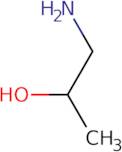Informations sur le produit
- (.+-.)-1-Amino-2-propanol
- (2-Hydroxy-2-methylethyl)amine
- (RS)-1-Amino-2-hydroxypropane
- (RS)-1-amino-2-propanol
- 1-Amino-2-hydroxypropane
- 1-Aminoisopropanol
- 1-Aminopropan-2-ol
- 1-Aminopropane-2-Ol
- 1-Methyl-2-aminoethanol
- 2-Amino-1-methylethanol
- Voir d'autres synonymes
- 2-Hydroxy-1-propanamine
- 2-Hydroxy-1-propylamine
- 2-Hydroxypropanamine
- 2-Hydroxypropylamine
- <span class="text-smallcaps">DL</span>-1-Amino-2-propanol
- DL-1-Amino-2-propanol
- Mipa
- Mono Isopropanolamine
- Monoisopropanolamine
- Nsc 3188
- Propan-2-Ol, 1-Amino-
- Threamine
- α-Aminoisopropyl alcohol
- β-Aminoisopropanol
- 1,1',1''-nitrilotripropan-1-ol
- 2-aminopropan-2-ol
- Aminopropanol
- Amino-2-propanol
- 2-Propanol, 1-amino-
- Iso-propanolamine
- DL-Isopropanolamine
- (2R)-2-hydroxypropan-1-aminium
Isopropanolamine is an amide that is used as a solvent, stabilizer, and plasticizer. It has been shown to have the highest thermal expansion coefficient of any chemical compound. Isopropanolamine can be used in the manufacture of polyurethane adhesives and coatings. This chemical also has a high water permeability and can be used in the production of glycol ethers. Isopropanolamine is formed by the reaction of acetone with ammonia under pressure at room temperature. The reaction mechanism for this process is believed to involve hydrogen bonding between nitrogen atoms on adjacent molecules, which causes intramolecular hydrogen bonding to form a polymer chain. Isopropanolamine has potent antitumor activity when it is combined with other drugs such as vinblastine or 5-fluorouracil.





